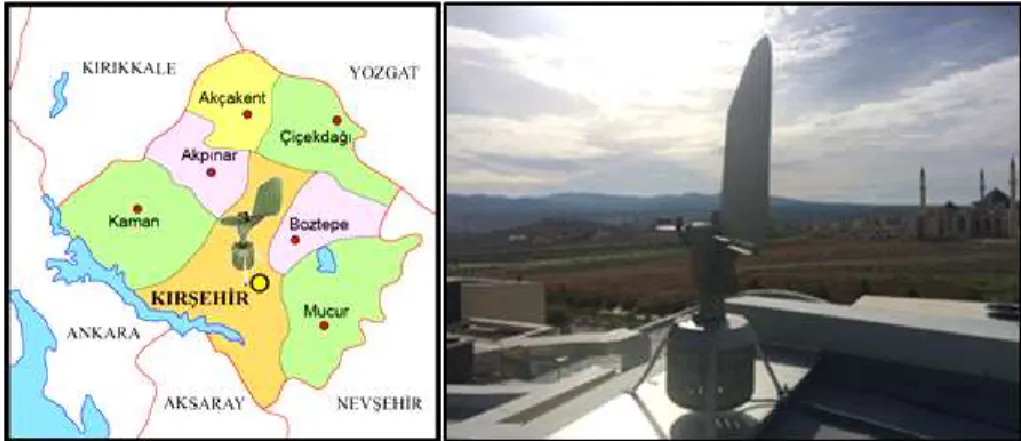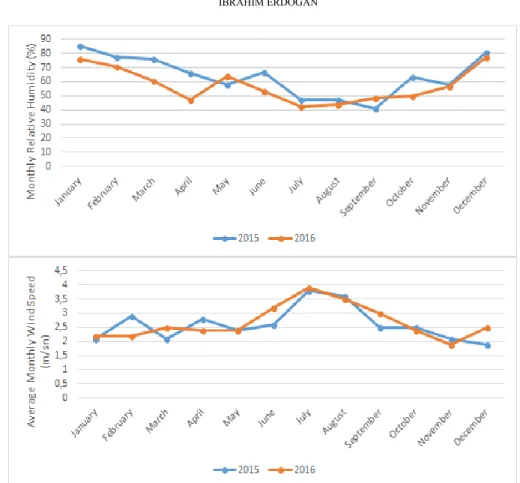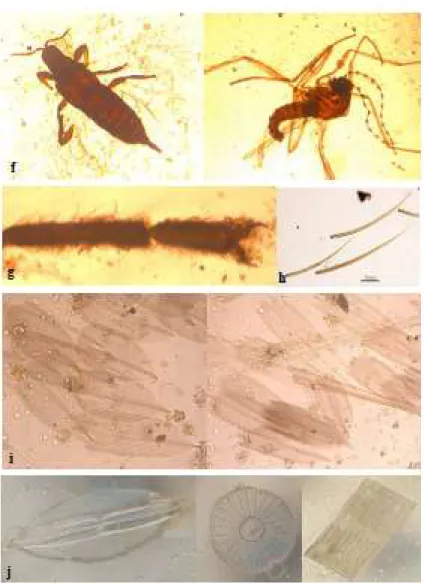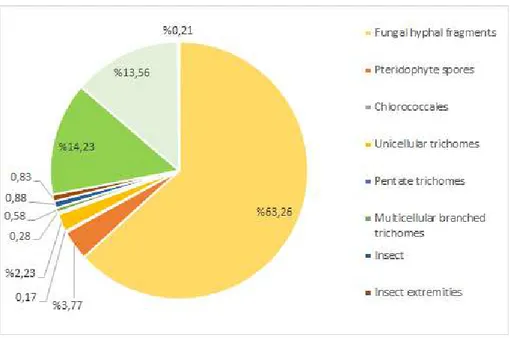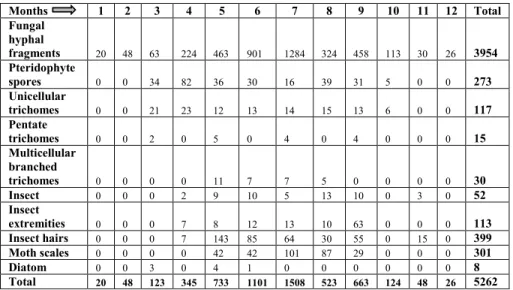Volume 27, Number 2, Pages 23-34 (2018) DOI: 10.1501/commuc_0000000195 ISSN 1303-6025
http://communications.science.ankara.edu.tr/index.php?series=C
Received by the editors: August 12, 2018; Accepted: September 10, 2018. Key word and phrases: Airborne, biological particles, Kırşehir, Türkiye
© 2018 Ankara University Communications Faculty of Sciences University of Ankara Series C: Biology
BIOLOGICAL AIRBORNE PARTICLES IN KIRSEHIR ATMOSPHERE EXCEPT FOR POLLEN AND FUNGAL SPORES
IBRAHIM ERDOGAN
Abstract. Aerobiology is a branch of biology that examines biological particles found both in the outdoor and indoor air. People's daily lives are influenced by these airborne biological particles in the air. Many people in society show an allergic reaction to these allergic airborne particles. A significant portion of the world's population reacts with airborne particles inhaled in various forms. The severity of these reactions varies with the degree of exposure to these particles over time and the concentration of the inhaled particles. In this study, for two years it has been investigated that biological particles (fungal hyphal fragments, pteridophyte spores, plant hairs, insect, insect extremities, moth scales, diatom etc. except for pollen and fungal spores) of Kirsehir atmosphere by using Burkard 7-day air sampler. In total, 4674 particles in 2015, and 5262 biological particles in 2016, have been counted.
1. Introduction
The air we breathe contains microscopic biological particles such as viruses, bacteria, fungal spores, fragments and pollen, some of them with relevant clinical importance. It is important to know when the biological particles such as pollen, fungal spores and the other biological particles are released into the atmosphere, their density in the atmosphere, and their relationship with the climate in terms of Aerobiology knowledge. Numerous studies have been carried out on pollen and fungal spores in the atmosphere and their allergic potentials [1-6]. Algae, protozoa, microfungi hyphae, bryophytes and fern fragments and insect and insect fragments that are present in humans, even if not as much as pollen and spores, cause important allergic reactions [7-10]. In this study, we have tried to identify other types of biological particles (fungal hyphal fragments, pteridophyte spores, plant hairs, insect, insect extremities, moth scales, diatom etc.) observed in Kirsehir atmosphere, except for pollen and fungal spores.
IBRAHIM ERDOGAN 24
2.MATERIALS AND METHODS
2.1 Study area
Kirsehir province is in the Middle Kızılırmak section of the Central Anatolia Region. Nevşehir, Aksaray, Kırıkkale, Yozgat and Ankara, the width of the territory of the province is 8% in the territory of the country and 2.9% of the territories in the Central Anatolia Region. It is located at an altitude of 985 meters from the sea.
Figure 1. Location map of Kirsehir and Burkard volumetric 7-day air sampler
2.2 Collection of airborne particles
Biological particles were collected using a 7-day recording volumetric Burkard spore trap during 2015-2016. The trap was placed on the roof of the Kirsehir Ahi Evran University, Faculty of Arts and Sciences building in Kirsehir at a height of 12 m above ground level (Figure 1). Atmospheric sampling and analysis followed the method described by the Spanish Aerobiological Network (REA) [11]. Particles counts were converted into daily average concentrations.
FUNGAL SPORES
2.3 Meteorological data
Monthly meteorological data (temperature, relative humidity, precipitation and wind speed) were obtained from the Turkish State Meteorological Service located at Ankara (Figure 2).
IBRAHIM ERDOGAN 26
Figure 2. Monthly Meteorological Datas
3.RESULTS
During the study year 2015, the average temperature was 12.2 ºC, in 2016 the average temperature was 12.3 ºC while the average temperature for long term period (1930-2017) in Kirsehir was 11.5 ºC. The warmest month was August in 2015 and 2016. The annual average rainfall for the period 1930-2017 was 31.4 mm. However, over the study period (2015) the annual average rainfall was 39.2 mm and the annual average humidity was 63.9%. In 2016 average rainfall was 41.4 mm and annual average humidity was 57.5%. The wettest month was June in 2015, January in 2016 (Figure 2).
FUNGAL SPORES
IBRAHIM ERDOGAN 28
Figure 3. a- Fungal hyphal fragments, b- Pteridophyte spores, c,d,e- Plant hairs, f- Insects, g,h- Insect extremities and hairs, i- Moth scales, j- Diatoms
FUNGAL SPORES
In the atmosphere of Kirsehir, a total of 4674 biological particles were observed in 2015. A total of 5262 biological particles were observed in 2016 (Figure3). Fungal hyphal fragments were seen as the densest biological particles in the atmosphere for both years (Figures 4,5). Also, monthly changes of atmospheric biological particles are given below (Table 6,7).
IBRAHIM ERDOGAN 30
Figure 5. Distribution of biological particles, 2016
Months 1 2 3 4 5 6 7 8 9 10 11 12 Total Fungal hyphal fragments 33 75 25 161 251 664 1128 256 240 91 19 14 2957 Pteridophyte spores 0 0 19 49 23 34 22 15 11 3 0 0 176 Chlorococcales 0 0 4 0 2 0 0 0 2 0 0 0 8 Unicellular trichomes 0 0 16 20 20 11 10 12 13 2 0 0 104 Pentate trichomes 0 0 2 0 4 2 1 0 4 0 0 0 13 Multicellular branched trichomes 0 0 1 0 14 5 3 3 1 0 0 0 27 Insect 0 0 0 0 5 9 7 11 5 4 0 0 41 Insect extremities 0 0 0 4 4 2 9 3 17 0 0 0 39 Insect hairs 0 0 0 1 344 145 52 35 80 8 0 0 665 Moth scales 0 0 0 1 485 57 25 39 27 0 0 0 634 Diatom 0 0 4 0 5 1 0 0 0 0 0 0 10 Total 33 75 71 236 1157 930 1257 374 400 108 19 14 4674
FUNGAL SPORES Months 1 2 3 4 5 6 7 8 9 10 11 12 Total Fungal hyphal fragments 20 48 63 224 463 901 1284 324 458 113 30 26 3954 Pteridophyte spores 0 0 34 82 36 30 16 39 31 5 0 0 273 Unicellular trichomes 0 0 21 23 12 13 14 15 13 6 0 0 117 Pentate trichomes 0 0 2 0 5 0 4 0 4 0 0 0 15 Multicellular branched trichomes 0 0 0 0 11 7 7 5 0 0 0 0 30 Insect 0 0 0 2 9 10 5 13 10 0 3 0 52 Insect extremities 0 0 0 7 8 12 13 10 63 0 0 0 113 Insect hairs 0 0 0 7 143 85 64 30 55 0 15 0 399 Moth scales 0 0 0 0 42 42 101 87 29 0 0 0 301 Diatom 0 0 3 0 4 1 0 0 0 0 0 0 8 Total 20 48 123 345 733 1101 1508 523 663 124 48 26 5262
Table 7. Monthly changes of atmospheric biological particles in 2016 4. Discussion
In this study, we analyzed biological particles except pollen and fungal spores in Kirsehir atmosphere for 2015 and 2016. Other biological particles found outside the pollen and fungal spores in the atmosphere have also been studied before. These particles were found to have a slight allergic effect [12-13]. Biological particles such as viruses, bacteria, fungal spores and fungal hyphal fragments carried in the atmosphere cause major destruction on farmland and natural vegetation with diseases they suffer, and also cause great financial losses with pathogenic, toxic and allergenic effects on humans and animals [7]. Edmonds classified the primary pollutants in the atmosphere as natural and human sources, and described volcanic fires, pollen, terpenes, viruses, bacteria, fungi, plant particles, algae, mites and microfauna as natural pollutants. Hyphal fragments have been observed in ambient air in several studies [14-15-16]. It is suggested that airborne hyphae are most commonly unbranched conidiophores that can be 1-100 μm in length but that are more commonly 5-40 μm [17]. Similarly, the most common biological particles were fungal hyphal fragments for both years in our study and they were generally
IBRAHIM ERDOGAN 32
unbranched with 20-200 μm in length (Figures 3,4). Also, trichomes were found secondly dominant among the biological particles in atmosphere and since the plant trichomes perform defense function, they may show irritant effects as well as allergic effects in humans when they are taken by respiration due to the various acids and foliage they contain [18]. At low concentrations, algae, fern spores and diatomaceous were found in Kirsehir atmosphere. It is reported that single-celled algae or algae fragments could be retained by the respiratory tract mucosa for bending and thus play a role in respiratory diseases and allergies [7]. Also, in the atmosphere of Kirsehir, insect, insect extremities, insect hairs, moth scales were found. Mites and micro-fauna particles are allergic and irritant as well, when inhaled. The importance of knowing the periods and intensities of these airborne particles is quite crucial for sensitive individuals to take protective measures and to take necessary precautions for people who works in agricultural and natural areas.
Acknowledgement
I would like to thank specially staff of the Ankara University Palynology Lab who supported me in this work.
References
[1] N.M. Pinar, N. Şakiyan, Ö. İnceoğlu, A. Kaplan, A one-year aeropalynological study at Ankara, Turkey, Aerobiologia, 15(4), (1999) 307-310.
[2] N.M. Pinar, F. Geven, G.N. Tuğ, O. Ketenoğlu, Ankara atmosferinde Gramineae polen sayılarının meteorolojik faktörlerle ilişkisi (1999-2002),
Astım Allerji İmmünol, 2, (2004) 65-70.
[3] T. Çeter, N.M. Pinar, K. Güney, A. Yildiz, B. Aşcı, M. Smith, A 2-year aeropalynological survey of allergenic pollen in the atmosphere of Kastamonu, Turkey, Aerobiologia, 28(3), (2012) 355-366.
[4] A. Bicakci, N. Sapan, H. Malyer, Airborne pollen calendar of the central region of Bursa (Turkey), Aerobiologia, 12(1), (1996) 43-46.
[5] A.S. Bülbül, S. Pehlivan, Investigation of airborne pollen grains in Kirsehir,
FUNGAL SPORES
[6] A.S. Bülbül, T. Ceter, E. Hüseyin, Kırşehir atmosferi mantar sporları konsantrasyonu ve meteorolojik faktörlerin etkisi, Asthma Allergy
Immunology/Astim Allerji Immunoloji, (2011) 9(3).
[7] R.L. Edmonds, Aerobiology: the ecological systems approach, (1979) (No. 576 E3).
[8] Jr. R.M. Brown, Studies of Hawaiian algae No.I. The atmospheric dispersal of algae and fern spores across the Islands of Oahu, Hawaii. Contributions in Phycology, Kansa, USA: Allen Press, (1971) 171-8.
[9] N.G. Maynard, Significance of air‐borne algae, Zeitschrift für allgemeine
Mikrobiologie, 8(3), (1968) 225-226.
[10] T. Çeter, N.M. Pınar, Ş. Alan, Ö. Yıldırım, Polen ve sporların haricinde atmosferde bulunan allerjen biyolojik partiküller, Asthma Allergy Immunol, 6 (2008) 5-10.
[11] C.G. Soldevilla, P.C. Gonzalez, P.A. Teno, E.D. Vilches, Spanish Aerobiology Network (REA): management and quality manual, Servicio de publicaciones de
la Universidad de Córdoba, (2007) 1-300.
[12] W.A. Marshall, M.O. Chalmers, Airborne dispersal of Antarctic terrestrial algae and cyanobacteria, Ecography, 20(6), (1997) 585-594.
[13] J.P. McGovern, T.R. McElhenney, R.M. Brown, Airborne algae and their allergenicity. I. air sampling and delineation of the problem, Annals of allergy, 23, (1965) 47-50.
[14] R.L. Górny, T. Reponen, K. Willeke, D. Schmechel, E. Robine, M. Boissier, S.A. Grinshpun, Fungal fragments as indoor air biocontaminants, Applied and
Environmental Microbiology, 68(7), (2002) 3522-3531.
[15] B.J. Green, E.R. Tovey, J.K. Sercombe, F.M. Blachere, D.H. Beezhold, D. Schmechel, Airborne fungal fragments and allergenicity, Medical Mycology, 44(Supplement_1), (2006) 245-255.
[16] V. Després, J.A. Huffman, S.M. Burrows, C. Hoose, A. Safatov, G. Buryak, R. Jaenicke, Primary biological aerosol particles in the atmosphere: a review,
Tellus B: Chemical and Physical Meteorology, 64(1), (2012) 15598.
[17] R.J. Sinha, C.L. Kramer, Identifying hyphal fragments in the atmosphere,
Transactions of the Kansas Academy of Science (1903), (1971) 48-51.
[18] B. Aşcı, T. Çeter, Ş. Alan, N.M. Pınar, B. Yalçınkaya, Ankara Havasının Doğal Kirleticileri, Biyoloji Bilimleri Araştırma Dergisi (BİBAD), 3(1), (2010) 19-25
IBRAHIM ERDOGAN 34
Current Address: Ibrahim ERDOGAN Kirsehir Ahi Evran University, Faculty of Agriculture,
Department of Agricultural Biotechnology, Plant Biotechnology Division, 40100 Bagbasi, KIRSEHIR
e-mail: ibrahim.erdogan@ahievran.edu.tr ORCID: https://orcid.org/0000-0002-9583-0474
